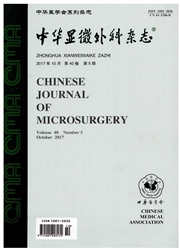

 中文摘要:
中文摘要:
目的以新型巯基烷基化壳聚糖(TACS)为载体介导重组共表达质粒pIRES—hVEGFl2lcDNA/hBMP4体外转染大鼠骨髓间充质干细胞(MSCs),探讨TACS用作骨组织工程中基因载体的可行性。方法复凝聚法制备TACS-基因纳米粒,检测其形态和粒径;全骨髓培养法分离、培养大鼠MSCs;将纳米粒转染第3代大鼠MSCs,并设壳聚糖组、脂质体组及裸质粒组分别为实验对照、阳性对照及阴性对照,噻唑蓝(MTT)比色法测定TACS的细胞毒性。分别于转染后3、4d提取MSCs的总RNA、总蛋白,逆转录-聚合酶链反应(RT—PCR)和Western blot检测目的基因的表达。结果TACS能有效包裹和保护共表达质粒,TACS组细胞存活率(73.18±6.56)%,明显高于脂质体组(45.92±4.93)%(P〈0.01)。除阴性对照组外,RT-PCR和Western blot均检测到转染后MSCs中hVEGFl2l及hBMP4的表达,TACS组目的蛋白表达量低于脂质体组(P〈0.05),但明显高于壳聚糖组(P〈0.01)。结论共表达质粒在TACS介导下成功转染大鼠MSCs并获得表达。TACS细胞毒性小,且较未改性壳聚糖转染效率明显提高。
 英文摘要:
英文摘要:
Objective The recombinant coexpression plasmid of pIRES-hVEGFl2lcDNA/hBMP4 was transfected into rat bone marrow mesenchymal stem cells (MSCs) mediated by thiolated N-alkylated chitosan (TACS), and the feasibility of using TACS as a gene vector in bone tissue engineering was investigated. Methods The TACS-pDNA nanoparticles were prepared by complex coacervation. The morphology and size of nanoparticles were observed under the transmission electronic microscopy and nanoparticle size analyzer. MSCs were isolated and cultivated from the bone marrow of rats. TACS bearing pIRES- hVEGFl2lcDNA/hBMP4 was transfected into the third generation of MSCs. Meanwhile, chitosan (experimental control) group ,liposome (positive control) group and naked pDNA (negative control) group were set up. Effect of the nanoparticles on cell viability was illustrated by MTT assay. At the 3rd and 4th day after transfection, the total RNA and total protein were extracted from MSCs respectively. The target gene expression was detected by RT-PCR and Western blot. Results TACS could protect the encapsulated pDNA effectively. Cell viability of TACS group (73.18 ± 6.56)% was significantly higher than positive control group (45.92 ± 4.93 ) % (P 〈 0.01 ). HVEGFl2l and hBMP4 were expressed in transfected MSCs detec ted by RT-PCR and Western blot except the negative control group. The target protein expression in TACS group was lower than in positive control group ( P 〈 0.05 ), but significantly higher than in experimental control group ( P 〈 0.01 ). Conclusion The coexpression plasmid was transfected into MSCs successfully by TACS. TACS has low cytotoxicity and its transfection efficiency was obviously higher than non-modified chitosan.
 同期刊论文项目
同期刊论文项目
 同项目期刊论文
同项目期刊论文
 Facile preparation of biodegradable chitosan derivative having poly(butylene glycol adipate) side ch
Facile preparation of biodegradable chitosan derivative having poly(butylene glycol adipate) side ch Preliminary study of thiolated N-Alkylated Chitosan-pDNA nanoparticles as a new vector in gene deliv
Preliminary study of thiolated N-Alkylated Chitosan-pDNA nanoparticles as a new vector in gene deliv Preparation of size-tunable, highly monodisperse particles by self-assembly of N-phthaloylchitosan-g
Preparation of size-tunable, highly monodisperse particles by self-assembly of N-phthaloylchitosan-g Preparation, characterization and aggregation behavior of amphiphilic chitosan derivative having Pol
Preparation, characterization and aggregation behavior of amphiphilic chitosan derivative having Pol Preparation of Thermal-Responsive Chitosan-Graft-
N-Isopropylacrylamide Membranes via γ-Irradiation.
Preparation of Thermal-Responsive Chitosan-Graft-
N-Isopropylacrylamide Membranes via γ-Irradiation. Effective loading and controlled release of indomethacin by amphiphilic chitosan derivative aggregat
Effective loading and controlled release of indomethacin by amphiphilic chitosan derivative aggregat 期刊信息
期刊信息
